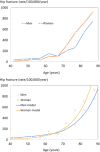Epidemiology of hip fracture and the development of FRAX in Ukraine
- PMID: 28567714
- PMCID: PMC5486686
- DOI: 10.1007/s11657-017-0343-2
Epidemiology of hip fracture and the development of FRAX in Ukraine
Abstract
A country-specific FRAX model has been developed for the Ukraine to replace the Austrian model hitherto used. Comparison of the Austrian and Ukrainian models indicated that the former markedly overestimated fracture probability whilst correctly stratifying risk.
Introduction: FRAX has been used to estimate osteoporotic fracture risk since 2009. Rather than using a surrogate model, the Austrian version of FRAX was adopted for clinical practice. Since then, data have become available on hip fracture incidence in the Ukraine.
Methods: The incidence of hip fracture was computed from three regional estimates and used to construct a country-specific FRAX model for the Ukraine. The model characteristics were compared with those of the Austrian FRAX model, previously used in Ukraine by using all combinations of six risk factors and eight values of BMD (total number of combinations =512).
Results: The relationship between the probabilities of a major fracture derived from the two versions of FRAX indicated a close correlation between the two estimates (r > 0.95). The Ukrainian version, however, gave markedly lower probabilities than the Austrian model at all ages. For a major osteoporotic fracture, the median probability was lower by 25% at age 50 years and the difference increased with age. At the age of 60, 70 and 80 years, the median value was lower by 30, 53 and 65%, respectively. Similar findings were observed for men and for hip fracture.
Conclusion: The Ukrainian FRAX model should enhance accuracy of determining fracture probability among the Ukrainian population and help to guide decisions about treatment. The study also indicates that the use of surrogate FRAX models or models from other countries, whilst correctly stratifying risk, may markedly over or underestimate the absolute fracture probability.
Keywords: Austria; Epidemiology; FRAX; Hip fractures; Ukraine.
Conflict of interest statement
Professor Kanis led the team that developed FRAX as director of the former WHO Collaborating Centre for Metabolic Bone Diseases; he has no financial interest in FRAX. Professors McCloskey, Oden, Harvey and Dr. Johansson are members of the FRAX team. Professors Harvey, Kanis and McCloskey are members of the Expert Advisory Group of the National Osteoporosis Guideline Group, UK. The other authors have disclosed no conflicts of interest.
Figures


References
-
- Kanis JA, on behalf of the World Health Organization Scientific Group . Assessment of osteoporosis at the primary healthcare level. Technical report: WHO Collaborating Centre, University of Sheffield, UK; 2008.
MeSH terms
Grants and funding
LinkOut - more resources
Full Text Sources
Other Literature Sources
Medical

